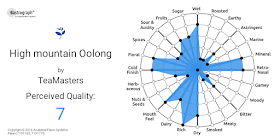Some of these remarkable wares are over a hundred years old! What I like is that they are not just meant to be admired, but they are still being used on special occasions!
On the second Day of this event, the Tea Institute showed its gratitude to its founder, Jason Cohen, by naming this Gallery of Asian Art after him. Samuel Li, the current director, gave the sign to Jason next to his delighted parents.
Jason Cohen graduated a few years ago and has now moved to NYC with the startup company he has founded, Gastograph, that specializes in analytical flavor systems. It aims at using rational measurements to taste and aromas of a big range of food and beverages (chocolate, coffee, beer, wine... and tea).
This is what their tool looks like when I use it to describe my latest Da Yu Ling 95K High Mountain Oolong from spring 2017:
I made this with the free App that exists both for Android and iOS. (Search: Gastograph) It can be a helpful tool to analyze the flavors of the tea, putting words and concepts on your feelings and remembering your experience. So, as you can see, Jason's company is deeply rooted in his Chinese tea tasting experience and his engineering background! And even if most of his customers are beer breweries and coffee makers, Jason continues to brew tea the same as he innovates, fearlessly: so many cups and such a little teapot!
During the first day, we learned that the Chinese achieved the first porcelain wares during the Eastern Han dynasty some 2000 years ago. The technique continued to improve with time. After the Eastern Jin (265-420), kilns in Jiangxi invented the saggar. Saggars are flame-resistant containers that protect the porcelain ware during the firing. This gives them a nicer and more even gloss and keeps the porcelain almost spotless.
White ceramics developed mostly in the North of China (ex: Ding ware from Hebei), but the climax of white porcelain was achieved in the south, in the kilns of Dehua in Fujian Province during the late Ming/early Qing period. French historian Albert Jacquemart (1808-1875) coined the term 'Blanc de Chine' (white from China) to call Dehua porcelain, a sign of Dehua's fame.
While we're focusing our study on porcelain tea cups, Dehua was actually even more famous for its sculptures of deities (ex: Guanyin with or without child).
This tall cup is a good example of the ivory (lard) hue of Dehua porcelain. The porcelain is rather thin and allows for the light to shine through the body. This reveals then a finely calligraphied Chinese poem!
This touches to key concepts of Chinese beauty dating back to the Sung dynasty: simplicity, refinement and purity. At first sight, the cup doesn't look that special, especially now that porcelain production has been industrialized. But instead of showing off the beauty of the calligraphy by painting with color, the artist chose to make it transparent and only visible under a direct light.
And, most amazingly, the tea tasted different when it had been poured from this cup. The taste was smoother, more refined and deeper. We could have used the Gastograph app to measure and analyze the difference! All the participants felt it. But it was no miracle or magic, just the result of using an antique cup made with natural ingredients, rested clay, wood fired in kilns with multiple chambers. For all these reasons, Dehua cups have the best impact on many teas (and Wuyi Yan Cha in particular) and we were lucky to experience it!
 |
| The character 'wine' |
This small Dehua cup gives us a better explanation: most of such cups had dual use for wine and tea. We have proof for this in this cup: the characters Jiu and Cha were both written on the same cup!
 |
| The character 'tea' |












Thank you for all the help and support Stephane!
ReplyDeleteSo much of what we learned in the institute with you and Teaparker is included in Gastrograph,
and we wouldn't be where we are without you.
Looking forward to the next event already!
All the best,
Jason